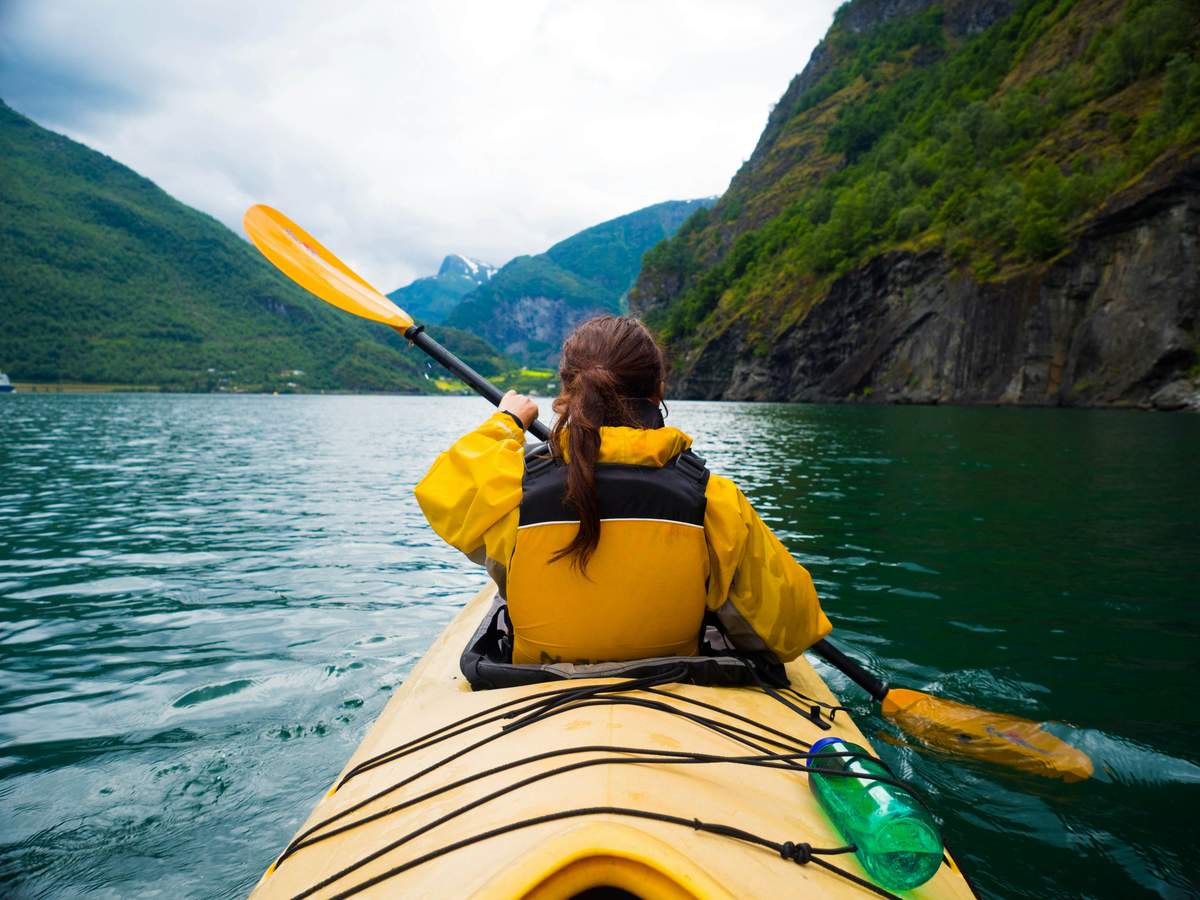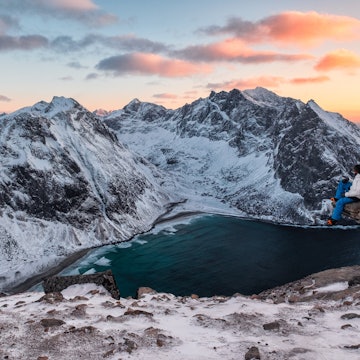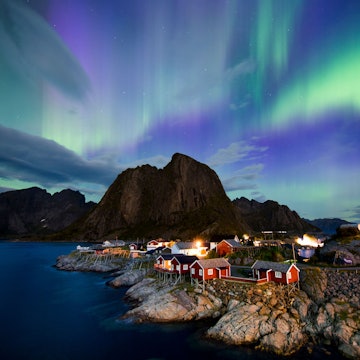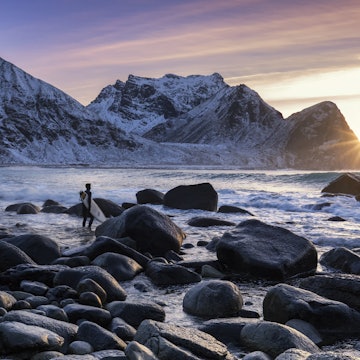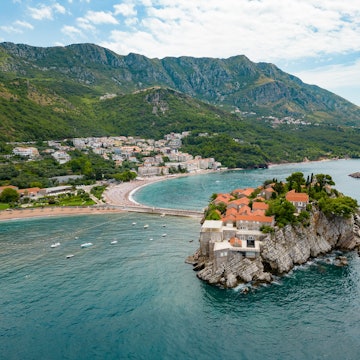
Discover the secret to the Lofoten Islands' beauty (hint: it's in the water)
Dec 6, 2020 • 11 min read

Dramatic granite peaks loom over the pretty fishing village of Reine, which circles a placid lagoon on the western island of Moskenesøy © Matt Munro / Lonely Planet
With so much of the world inaccessible right now, we’re taking a look through our archive of travel writing to revisit our past trips and to look at how Lonely Planet has spent decades exploring the world in the hope of better understanding it.
In this piece from 2010, writer Orla Thomas visits Norway’s Lofoten Islands to find that the surrounding Arctic waters are far more than a scenic backdrop – the sea is the islands’ lifeblood, a source of great wealth and unforgettable stories.
The tiny wooden fishermen’s huts that cling to the shore of Norway’s Lofoten Islands look too flimsy to survive in this prehistoric landscape. Towers of granite loom over these insubstantial red and yellow structures, which are scattered along the water’s edge like Lego bricks tossed aside by a petulant giant.
But these modest homes are palatial when compared with those of the islands’ first inhabitants. Until the first rorbuer (fishermen’s cottages) were built here in 1120, Lofoten fishermen used to sleep beneath their upturned vessels before flipping them over for a day at sea.

Once the people who came here were at the mercy of nature, but now they rush to embrace it. Holidaying Norwegians making the short hop from the mainland now occupy some of the simple wooden huts built to house fishermen.
They come to see the magnificent Lofotenveggen (Lofoten Wall – so-called because of the way the islands’ mountains stretch out across the sea in a seemingly unbroken chain) and to explore the deserted beaches, hidden fjords and patches of virgin green behind each spiky peak.
Fishing still dominates island life, and the evidence is everywhere you look – from the seafood dishes listed on each restaurant menu to the giant, A-shaped drying racks in every harbor, where gutted cod are hung in pairs. Stockfish, or dried cod, has historically been Norway’s most valuable export commodity – these ugly creatures made Norway rich.
Morten Nilsen is a fifth-generation Lofoten fisherman and left school at 15 to join his father aboard his trawler, Hellvåg. Between January and April, the peak fishing season here, Morten is so busy at sea that he sometimes sleeps just 20 hours a week, casting out lines every day from 3 o’clock in the morning until 8 o’clock at night.
But even in these plentiful waters, cod isn’t the lucrative business that it once was – overfishing has depleted supplies and demand for stockfish has dwindled. Fishermen like Morten have been forced to diversify.

During the summer, Morten uses Hellvåg to take paying passengers out to the Moskenesstraumen Strait, the site of the mighty whirlpool that inspired Edgar Allan Poe’s "A Descent into the Maelstrom." This is not merely a fictional demon, but the result of conflicting tidal currents between two of the Lofoten Islands, Moskenesøy and Værøy.
"There have been some moments," says Morten. "In full moon, in bad weather, the current can be very strong, very powerful."
His hands at Hellvåg’s wheel, he glances at the blinking green screen that plots our course towards the maelstrom’s center.
"My great, great grandfather perished in the maelstrom."
A ship’s captain, Morten’s ancestor was 70 years old when the current dragged him under one December night in 1907.
"He’d already survived, six times, a maelstrom accident," says Morten, his cheeks flushed pink with the drama of the story, his blue eyes full of life. "The first time, he was a newborn baby. His mother wasn’t married and, because of the shame she had brought on her family in the village of Henningsvær, she had run away in a rowing boat."
The villagers of Hell spotted the pair’s stricken vessel and sent out a rescue party, and it is this now-abandoned hamlet that gave Morten’s boat its name.
Suddenly, Hellvåg begins to pitch from left to right, lurching like a drunk across the ocean’s surface. "We have arrived," says Morten, stepping out from the drowsy warmth of the cabin. A slew of water rushes across the deck, drenching our shoes.
"This is a calm day, but sometimes the waves here can be 12 or 15 meters high. Can you see?" he points to the churning deep, "how the water seems to be boiling?" This is the Moskenesstraumen maelstrom: the seas Poe described as "lashed into ungovernable fury."
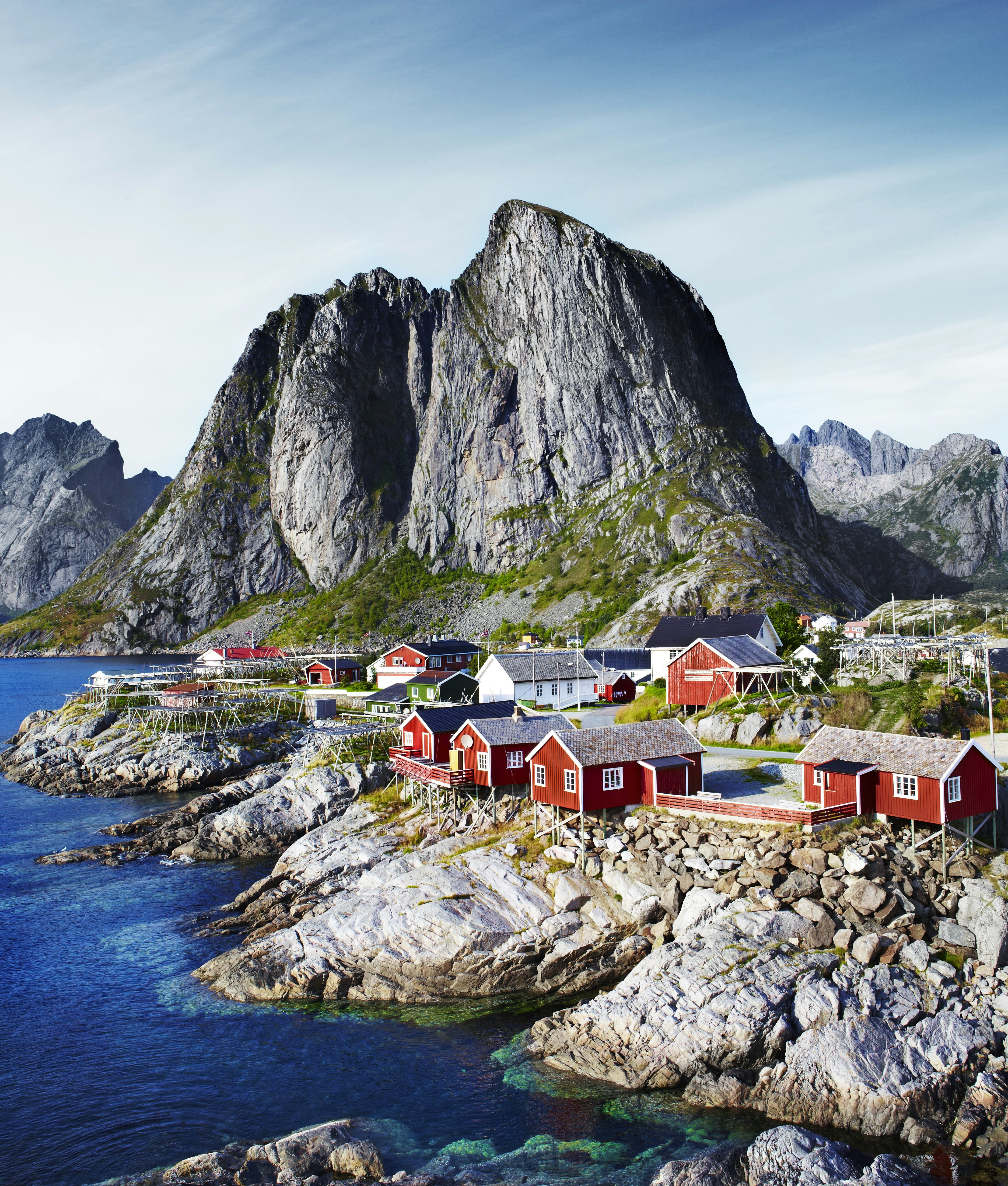
"I am not frightened by the sea because I have learned to respect it."
Morten has been forced to make his peace with these angry waters because, to reach the best spots for fishing, he must navigate his way through them every day (though he only takes tourists when the weather is calm).
"Out here on the water, I feel free. People who don’t know this area don’t like it, but I am not frightened by the sea because I have learned to respect it." Morten’s lesson, a valuable one in an environment where nature daily reasserts its dominance, came from his grandmother.
Her wisdom drew upon centuries of fisher-folklore. She warned Morten about Draugen, the ghost of all fishermen lost at sea, a headless man dressed in oilskins who sails in a dilapidated half-boat and is said to appear when a man is drowning.
Marmæle is a more welcome vision. The son of a mermaid and, like his mother, a fish from the waist down, he is the voice of the sea. Thought to bring secrets from the deep, Marmæle will aid and protect those fishermen who heed his advice.
Morten admits a grudging faith in this phantasmal pair, mythical personifications of the very real anxieties suffered by fishermen.
"My grandmother taught me to believe in these things," he says. "She has made me a very superstitious man." As Morten begins expertly to steer Hellvåg out from the maelstrom, it is with Marmæle whispering in his ear.

Heike Vester has no dread of the creatures of the deep, but each day longs for them to come to the surface. "Whales are my passion – when I don’t see them I become very frustrated, very depressed." A marine biologist from Germany, Heike is quiet and intense, but her petite frame becomes animated when she talks about her research subject: the sounds made by pilot and killer whales. Pressing play on a recording stored on her computer, she tilts her head as a mournful call fills the room. "Listen! It’s so beautiful," she says. "Like bird song, or music."
Although the complex medley of cries, clicks, whistles and squeaks emitted by whales is relatively uncharted academic territory, Heike hasn’t been able to get funding for her PhD, so started a science center in Henningsvær to help pay for her research.
Visitors to Ocean Sounds can learn about Arctic marine life on dry land or take a sea safari with Heike on her Zodiac research boat. She hopes that "by showing people the beauty of nature, they will want to protect it – and nowhere is it more beautiful than here."
The dull roar of the rib boat’s engine is the only sound as we head out into Vestfjorden, Heike pointing out cormorants and guillemots flying overhead.
"I don’t know why the whales come here. It’s such a quiet, calm and peaceful place – perhaps they come to rest? It’s just a guess. There’s so much we don’t know about them." Some of her subjects are as curious about her as she is about them. "Last week I was out here making recordings and a baby pilot whale came up to take a look at me. I tried to talk to him, mimicking the sounds I have learned, and he got very excited. He lay on the surface and chatted to me until his mother took him away."

As we reach a crop of rocks Heike stops the boat and we sit for a few minutes in silence. There are no whales to be found today, but a family of seals are content for us to watch as they bask and play in the milky light of the Arctic sun. Some consider seals and whales to be the sea’s most loveable beasts, their grinning faces effortlessly anthropomorphic, but Heike’s enthusiasm for their protection is not one all Norwegians share – both sealing and whaling are legal here.
"Once I was out with a group, and a whaler took a shot at a minke whale we were watching," she remembers. "The harpoon missed and my group let out a big cheer but, of course, the whaler was really mad. We still have a lot of work to do up here, to make people see why these animals need to be protected."
Norwegians are devoted to their land, and could never be accused of taking their share of the great outdoors for granted. The country has a strict environmental policy and its citizens are fiercely committed to the ancient law of allemannsretten (literally "every man’s right" – preserving public access to wild areas). Many employers shorten office hours during the summer – explore the Lofoten Islands at twilight and you’ll see happy workers enjoying the last of the sunshine on bikes, boats and on foot.
These islands are among Norway’s most exposed territories, so those who live on them cannot afford to be fair-weather in their commitment to the outdoors. I’ve heard a rumor of a group of women in Stamsund who swim in the sea daily at 7am, whatever the season.
Early one summer morning, I pull up outside the town’s only hotel. There’s no doorman; the only red coat in sight belongs to a tame and well-fed fox, which snuffles my hand in greeting. Inside, the hotel is dilapidated, the breakfast buffet sparse. The waiter who pours me a watery coffee tells me it is soon to close. "Stamsund doesn’t need a hotel," he says. "We only have two attractions – the fox, and Euri Ingebrigtsen."

And on the hour, there is Euri, her wild blonde hair obviously recently separated from its pillow. Wearing a dressing gown and flip-flops, a towel tucked under her arm, she walks purposefully along the town’s deserted high street.
"Joining us?" she says in welcome, as we make our way to the ocean’s edge. "There are four of us who swim together: neighbors. We’ve been doing it every morning for seven years." And, like phantoms, the other swimmers appear, emerging one by one from behind the rocks and small houses.
The water is bone-chilling yet it will get much colder before the year is out.
"I’ve swum here in mid-winter; the water must have been about 2°C," Euri tells me. "The worst is when it snows – that really gets into your skin." The swim is brief and the four women change hurriedly. Their working day begins at 8 o’clock – Euri is a doctor, Torill a psychologist, Karin a journalist and Elisabeth, unexpectedly, a clown. All are emphatic about the health-giving properties of their icy daily dip.
"It makes you laugh in the morning," says Euri, "and I think that’s very important."
Pulling a hat over her white hair, Euri’s friend Torill agrees. She tells me about the brief time when she lived on the mainland. "I’ve never been so sick as those months
I didn’t swim! My body missed the sea."

The ocean gets everywhere in the Lofoten Islands. The coast is visible with every curve of the archipelago’s one single road, the E10, which connects the islands by a series of bridges and causeways. Deep fjords allow the salty waters to creep inland and vast, still, lake-like pools are given away by the rim of seaweed left at high tide. This otherworldly landscape and ethereal Arctic light have long been a draw for artists, and the Lofoten Islands have a cultural community disproportionately large for their tiny size.
Seventy-four-year-old Swedish artist Else-Maj Johansson first visited the islands on holiday when she was 22. Enamored with their beauty and the free-spirited people, she vowed to return and, in 1969, she did, bringing with her a boyfriend. The romance didn’t last, but her enchantment with the islands did and she’s lived here, on and off, ever since.
"The light’s incredible, particularly in the summer," she tells me as the last of it pours through the windows of her studio in Sørvågen. "I prefer the sunshine, but of course it’s bad weather and stormy seas that make better art – you can see for yourself,’ she says, casting her arm towards the canvases around the room.
Else-Maj scoffs when I ask if the islands’ aesthetic appeal ever fades. "Never! It’s always changing. In summer you get the midnight sun, and in winter the Northern Lights." But it’s not just the look of the place that made her stay, she says.
"The people here are wonderful; they’re so open."

The most western isles, like Moskenesøy where she lives, are wildest of all, says Else-Maj. Troll Valley, the cusp of which is visible from her window, has inspired many paintings.
"You don’t get more dramatic. It’s scary, and it’s beautiful – you can work with a motif like that for the rest of your life," she says. "It’s a feeling, as much as an image."
Two hours later and a steep walk up springy grass studded with blueberries, I find it. Jagged cliffs surround a lake turned moody blue by a darkening sky – shielding it from the winds, they maintain their own mirror image in its surface. At the water’s edge is a single cabin, a small boat tethered to its deck. If trolls exist, this is indeed where they would make their home.
I cast a glance over my shoulder at the great expanse of sea – nowhere on the Lofoten Islands are you deprived of an ocean view. It’s somehow easier to believe in myths when walking through a landscape that looks like it belongs to another world. Trolls and giants; headless sea-ghosts and ferocious whirlpools – only here could they feel so real.
You might also like:
Svalbard's call of the Arctic
Discover why the Accursed Mountains are Europe's most misunderstood region
Food, wine and Pinocchio in Italy's Lake District




